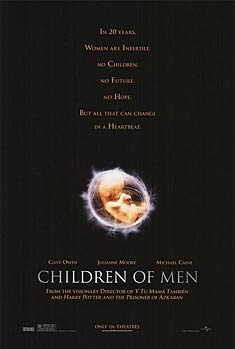Philip K. Dickathon: The Three Stigmata of Palmer Eldritch
Guest Blogger and WWEnd Member, Charles Dee Mitchell, has contributed a great many book reviews to WWEnd and we’ve invited him to contribute to our blog. This is the latest in Dee’s series of Philip K. Dick reviews that he started on his blog www.potatoweather.blogspot.com. We’ll be posting one every week until he runs out of reviews or gets tired of Philip K. Dick books.
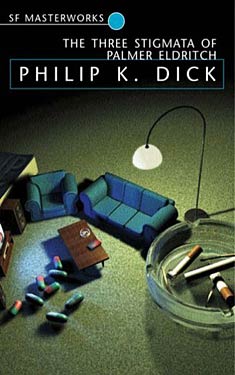 This is how bad things have gotten. Earth is over-heated and over-crowded. If you go outside during the day you must wear a portable cooling pack and stay under anti-thermal protective shades until you can grab a passing jet taxi or "thermosealed, interbuilding commute car." The U.N. has a forced emigration policy designed to provide colonists to Mars and a few other locations. But everyone knows that life off Earth will be even more miserable than what they face here. The colonists serve no real purpose since agriculture is difficult with frozen methane storms and pesky alien creatures that may eat either your struggling crops or yourself. When draft notices arrive, anyone who can afford one hires a psychiatrist in a box. Its purpose is to keep your mind so addled you will never pass the psych examination when the U.N. tries to ship you off to the boonies.
This is how bad things have gotten. Earth is over-heated and over-crowded. If you go outside during the day you must wear a portable cooling pack and stay under anti-thermal protective shades until you can grab a passing jet taxi or "thermosealed, interbuilding commute car." The U.N. has a forced emigration policy designed to provide colonists to Mars and a few other locations. But everyone knows that life off Earth will be even more miserable than what they face here. The colonists serve no real purpose since agriculture is difficult with frozen methane storms and pesky alien creatures that may eat either your struggling crops or yourself. When draft notices arrive, anyone who can afford one hires a psychiatrist in a box. Its purpose is to keep your mind so addled you will never pass the psych examination when the U.N. tries to ship you off to the boonies.
Barney Mayerson’s shrink is Dr. Smile, and he is supposed to be one of the best. But Barney should be able to beat his draft notice in any case. He is the New York Pre-Fash consultant for Perky Pat Enterprises. This means he uses his precognitive abilities to judge whether products presented as possible new additions to Perky Pat’s layout will be a success. PP is a doll with a dreamy life and dreamy boyfriend –let’s face it, they’re Barbie and Ken. Colonists in their Martian hovels spend hours playing with Perky Pat, aided by the illegal drug, Can-D. (The drug is manufactured on Venus by Perky Pat Enterprises.) A chaw of Can-D gives participants up to an hour or so of complete identification with PP and her world.
Life for Barney, his new girlfriend/assistant Betty, and their boss Leo Bolero is good until word comes that renegade industrialist Palmer Eldritch has crash landed on Pluto after a decade spent outside the solar system. Rumor has it that that he has brought back with him a new drug, Chew-Z. (PKD was never one to shy away from puns.) Chew-Z is better than Can-D. It requires no layouts but instead puts the user into a completely realized fantasy world. And Eldritch has won U.N approval, so it is legal. Perky Pat Enterprises will be destroyed.
This might be a good time to mention that The Three Stigmata of Palmer Eldritch is PKD‘s first overtly religious novel. It is one of seven novels written during the amphetamine-fueled years of 1963/64. There is some question as to when PKD first took LSD, but it is difficult not to imagine Can-D and Chew-Z as versions of marijuana and acid. Can-D is a party drug. Chew-Z promises to reveal new levels of reality. It is part of a spiritual quest, but it could also be a trap. There comes a Voltairian moment when Barney decides to chuck everything and just tend his own scraggly Martian garden. That doesn’t last for long. Barney’s quest will bring him into contact with the world of Chew-Z, Palmer Eldritch himself, and whatever exists beyond Palmer Eldritch.
This is the book that 30 years ago sold me on Philip K. Dick. I had seen Blade Runner and read, since it was supposed to be PKD’s best novel, The Man in the High Castle. I liked it OK, but then I happened to pick up Palmer Eldritch. The screwball pacing, deadpan humor, and imaginative monsters were the perfect cover for the serious thought that lurked in the background. Even though I was hooked — an appropriate term when discussing PKD — I read him only sporadically until this past year. Now reading all his SF in more or less chronological order is at times a pleasure, a chore, and even saddening. It’s my own Chew-Z trip. And I am just now getting to the good stuff.
Philip K. Dickathon: Eye in the Sky
Guest Blogger and WWEnd Member, Charles Dee Mitchell, has contributed a great many book reviews to WWEnd and we’ve invited him to contribute to our blog. This is the latest in Dee’s series of Philip K. Dick reviews that he started on his blog www.potatoweather.blogspot.com. We’ll be posting one every week until he runs out of reviews or gets tired of Philip K. Dick books.
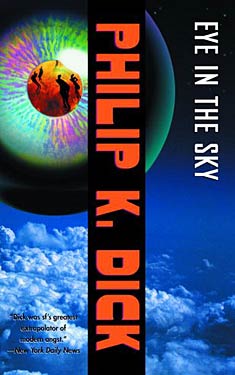 Philip K. Dick wrote Eye in the Sky in 1957 and set it in 1959. That’s not much of a leap as things go in sf novels, but it allows Dick to keep the society he describes, that of Northern California with its combinations of defense contractors and university types, contemporary. When I read the novel, I thought the slight time alteration also allowed him to create the fanciful Bevatron, some sort of particle accelerator whose malfunction propels the plot. But it turns out UC Berkeley did have a genuine Bevatron on hand, an early precursor of the CERN projects currently attempting to capture anti-matter along the Franco-Swiss border. The one in Belmont featured in the novel is fictional.
Philip K. Dick wrote Eye in the Sky in 1957 and set it in 1959. That’s not much of a leap as things go in sf novels, but it allows Dick to keep the society he describes, that of Northern California with its combinations of defense contractors and university types, contemporary. When I read the novel, I thought the slight time alteration also allowed him to create the fanciful Bevatron, some sort of particle accelerator whose malfunction propels the plot. But it turns out UC Berkeley did have a genuine Bevatron on hand, an early precursor of the CERN projects currently attempting to capture anti-matter along the Franco-Swiss border. The one in Belmont featured in the novel is fictional.
I doubt, however, that the real Bevatron could ever have caused the situation that arises in Eye in the Sky. Dick’s novel is a kind of The Bridge of San Luis Rey in reverse. Instead of learning the past of those characters that die in the collapse of a bridge in Peru, we enter the dream world of the victims of the Bevatron’s misfire, which has left them unconscious on the floor of the contraption. Initially they are all pleased to find they have come through the event relatively unscathed, but something has changed. They live in a theocratic society and a geocentric universe where the sun is a low-burning star rotating close to the earth, the moon is a tiny lump of matter, and when two characters ascend into the heavens by holding onto the handle of large black umbrella — don’t ask for details here — they see the fires of Hell burning below the earth and float over the walls of heaven where the great unblinking eye of God glares up at them.
The main action of the novel involves the characters’ efforts to extricate themselves from one world only to find themselves in another: the saccharine, sexually neuter land dominated by the whims of a prissy, middle-aged woman; the monster-filled world imagined by a paranoid old maid; and a fantasy of America as depicted in Communist propaganda.
The Communist angle figures large here. In the opening scene, Hamilton, our main character, loses his job at the missile plant when his wife comes under investigation for her possible left-wing sympathies. Dick and his wife were briefly investigated in Berkeley about the time he wrote this novel, but that could not have been all that uncommon an event in 1950’s Berkeley. In fact, Mr. and Mrs. Dick seemed to have got on well with their investigators. One of them taught Philip to drive, and his wife cooked for them. The relationship soured when the Dick’s turned down an opportunity to relocate to Mexico as spies.
The book is dated by other attitudes and behaviors. Everyone smokes like chimney, although that is probably true of most 1950’s fiction. The central character’s liberal attitude toward the "Negro situation" can be awkward, although Laws, the black character, is given one good chance to let loose on Hamilton. The ugliest aspects of the novel are Dick’s relish in describing the ugliness of two female characters, one obese and the other the uptight old maid who fills the world with monsters. Hamilton’s wife, on the other hand, is perfect in every respect. Silky is the only other female character. She is a bar waitress/prostitute who appears in each of the worlds, and her ever-changing breasts receive DIck’s usual level of scrupulous attention.
Going from dream world to dream world threatens to become boring, but the device Dick employs to cut things short is a cop out. The "normal" characters with a firm grasp on reality will not be creating any dystopias. The one twist at the end is not worthy of the dynamic Dick has put into play. Of course, nothing can live up to that umbrella ride to heaven that takes place so early on in the book.
The denouement is another charming period detail. Hamilton and Laws leave the defense industry to start producing state-of-the-art hi-fi equipment. This will usher in a new world of racial harmony and high-end electronics.
The Curé of Mars
I had the happy occasion to watch a sad movie recently.
The sad movie was Alfonso Cuarón’s Children of Men, and to my mind it demonstrates the best that science fiction can be.
It’s a deeply felt movie, intense and raw, the way that Saving Private Ryan is deeply felt, intense and raw. I say it’s a sad movie, because of the world it portrays (and how close that world looks like ours), but ultimately the film’s message is one of hope.
If you’re not aware of Children of Men, the narrative is simple yet beautiful. It is the year 2027, and humanity has lost the ability to procreate. Mankind is slowly dying out. Into this cauldron of despondency, a miracle occurs – a pregnant woman (presumably the only such in the world) is discovered, and Theo Faron (played by Clive Owen) must shuttle her to safe refuge, with the hope being that scientists can learn from her how to jumpstart the human race.
There are many things to admire about this film. The realism and believability of the situation. The reliance on the genuine humanity of the characters to tell the story, rather than special effects and wild concepts. The subdued messaging backgrounded throughout the film which doesn’t draw attention to itself but adds necessary grit and political color.
I’m more than halfway through P. D. James’ book of the same name right now (the source material for the film), and it is remarkably different. The book is pastoral, academic, an epistle of despair in a decidedly English tone; the film on the other hand is ripe with street-level danger, violence, anger.
I could go on and on about the many things I love about Children of Men, enough to write a paper, but for the purpose of today I’m just going to touch ever so briefly on the character of Theo Faron.
Jonathan McDonald recently posted a link on Worlds Without End to an article by Robert R. Chase regarding the relationship between science and religion in science fiction. I found the synchronicity of this posting to be fortuitous, as Children of Men is at its heart a very religious movie. And Theo Faron, despite his jaded, secular posturing, is a decidedly religious figure.
In fact, I would go so far as to say he’s a saint. Let me explain.
In considering Theo’s transformation from cynical loner to true and loyal guide, you can’t but help see him as a post-modern St. Joseph. Protector of the mother and her child, he leads her to safety despite many obstacles, giving of himself totally to his mission. Theo’s story is a beautiful psalm of self-donation.
To my mind, it is unmistakable that Cuarón and his fellow screenwriters drew inspiration for Theo Faron from the life of St. Joseph.
This led me to consider just how freely science fiction films can dip into the lives of saints for inspiration. What follows is a brief exploration of ten saints and the film characters who echo them.
10 Lives of Saints Appropriated for Science Fiction
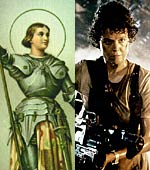 10. St. Joan of Arc – Joan’s life followed a dramatic path from a simple and seemingly inconsequential peasant to renowned warrior and leader who ultimately was burned alive for her faith.
10. St. Joan of Arc – Joan’s life followed a dramatic path from a simple and seemingly inconsequential peasant to renowned warrior and leader who ultimately was burned alive for her faith.
Cinema Equivalent: “Ellen Ripley” played by Sigourney Weaver / Alien3 (1992) – Ellen rises from a simple and seemingly inconsequential space trucker to become a leader of soldiers before being consumed by a fiery conflagration.
9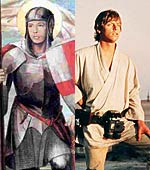 . St. George – A solider and priest, St. George is best known for his legendary exploit of vanquishing a dragon that dwelt in a lake and preyed upon a nearby town.
. St. George – A solider and priest, St. George is best known for his legendary exploit of vanquishing a dragon that dwelt in a lake and preyed upon a nearby town.
Cinema Equivalent: “Luke Skywalker” played by Mark Hamil / Star Wars: Return of the Jedi (1983) – A solider and priest, Luke counts among his most notable exploits the vanquishing of the Rancor Monster that dwelt in a pit in Jabba the Hutt’s lair.
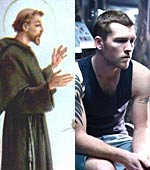 8. St. Francis of Assisi – A wild young man and one-time soldier who would undergo a conversion experience, renounce all he’d ever known to follow a simple life; a lover of nature, of the environment and of animals.
8. St. Francis of Assisi – A wild young man and one-time soldier who would undergo a conversion experience, renounce all he’d ever known to follow a simple life; a lover of nature, of the environment and of animals.
Cinema Equivalent: “Jake Sully” played by Sam Worthington / Avatar (2009) – A one-time soldier who would undergo a conversion experience, renounce all he’d ever known and discover an appreciation of nature, the environment and indigenous life.
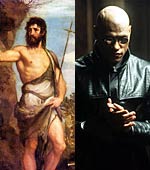 7. St. John the Baptist – During a period of struggle and conflict, he was a strong and courageous spiritual leader. St. John pointed the way for Jesus (the Messiah), whom he baptized in the Jordan River.
7. St. John the Baptist – During a period of struggle and conflict, he was a strong and courageous spiritual leader. St. John pointed the way for Jesus (the Messiah), whom he baptized in the Jordan River.
Cinema Equivalent: “Morpheus” played by Laurence Fishburne / The Matrix (1999) – During a period of struggle and conflict, he was a strong and courageous leader. Morpheus pointed the way for Neo (the One), whom he introduced to the world of the Matrix via the red pill of truth.
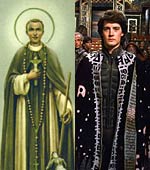 6. St. Martin de Porres – The illegitimate son of a nobleman and a former slave, St. Maretin’s family upbringing consisted of his mother and younger sister. A strong student who outshone his teachers, he became a worker of healing miracles and champion of the poor and disenfranchised.
6. St. Martin de Porres – The illegitimate son of a nobleman and a former slave, St. Maretin’s family upbringing consisted of his mother and younger sister. A strong student who outshone his teachers, he became a worker of healing miracles and champion of the poor and disenfranchised.
Cinema Equivalent: “Paul Atreides” played by Kyle MacLachlan / Dune (1984) – The illegitimate son of a nobleman and his concubine, Paul’s family upbringing consisted of his mother and younger sister. A strong student who outshone his teachers, he became a worker of miracles and champion of the disenfranchised Fremen.
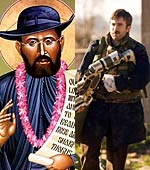 5. St. Damien of Molokai – Working among the quarantined outcasts of the leper colony of Molokai, St. Damien eventually succumbed to leprosy contamination.
5. St. Damien of Molokai – Working among the quarantined outcasts of the leper colony of Molokai, St. Damien eventually succumbed to leprosy contamination.
Cinema Equivalent: “Wikus van de Merwe” played by Sharlto Copley / District 9 (2009) – Working among the quarantined outcasts of the alien colony of District 9, Wikus eventually succumbed to alien contamination.
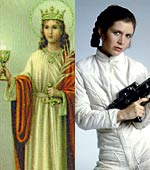 4. St. Barbara – Persecuted by her pagan father, who handed her over to the Roman authorities, St. Barbara refused to renounce her Christian affiliations.
4. St. Barbara – Persecuted by her pagan father, who handed her over to the Roman authorities, St. Barbara refused to renounce her Christian affiliations.
Cinema Equivalent: “Princess Leia” played by Carrie Fisher / Star Wars: A New Hope (1977) – Persecuted by her Sith father, who handed her over to the Imperial authorities, Princess Leia refused to renounce her rebel affiliations.
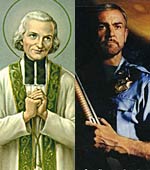 3. St. John Vianney, the Curé of Ars – An undistinguished man whose superiors held low expectations, St. John Vianney was assigned to the small out-of-the-way parish town of Ars, which he proceeded to single-handedly clean up from its vice-ridden and morally lawless ways.
3. St. John Vianney, the Curé of Ars – An undistinguished man whose superiors held low expectations, St. John Vianney was assigned to the small out-of-the-way parish town of Ars, which he proceeded to single-handedly clean up from its vice-ridden and morally lawless ways.
Cinema Equivalent: “Marshall O’Niel” played by Sean Connery / Outland (1981) – An undistinguished man whose superiors held low expectations, Marshall O’Niel was assigned to the small out-of-the-way mining station on Io, which he proceeded to single-handedly clean up from its vice-ridden and morally lawless ways.
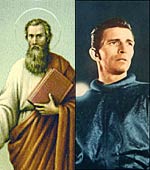 2. St. Paul – The great evangelist and missionary of the Church, St. Paul travelled far to deliver the message to the people of this world to atone for our obsession with sin, or perish.
2. St. Paul – The great evangelist and missionary of the Church, St. Paul travelled far to deliver the message to the people of this world to atone for our obsession with sin, or perish.
Cinema Equivalent: “Klaatu” played by Michael Rennie / The Day the Earth Stood Still (1951) – A great missionary from the stars, Klaatu travelled far to deliver the message to the people of this world to atone for our obsession with nuclear weapons, or perish.
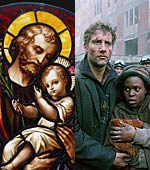 1. St. Joseph – At first reluctant to get involved, St. Joseph agrees to protect and defend the Virgin Mary and her baby. They undertake an arduous journey, and while on the road the Virgin Mary gives birth to the miracle child who is the hope of humanity. Father, mother and infant then flee into Egypt to escape persecution.
1. St. Joseph – At first reluctant to get involved, St. Joseph agrees to protect and defend the Virgin Mary and her baby. They undertake an arduous journey, and while on the road the Virgin Mary gives birth to the miracle child who is the hope of humanity. Father, mother and infant then flee into Egypt to escape persecution.
Cinema Equivalent: “Theo Faron” played by Clive Owen / Children of Men (2006) – Theo, approached by his former lover (Julian) to help secretly transport a girl (Kee) across security-tight Britain, is at first reluctant to get involved. When he discovers Kee’s pregnancy, however, he agrees to protect and defend Kee and her baby. They undertake an arduous journey, and while on the road Kee gives birth to the miracle child who is the hope of humanity. Theo, Kee and her baby must then flee out of the Bexhill Refuge camp to the sea.
I can’t do Children of Men justice with a paltry blog, but I can say that as long as our filmmakers continue to bring us deeply felt stories such as this, I have no doubt that science fiction film has a bright future.
DON’T FORGET – BATTLEFIELD EARTH CHARITY CHALLENGE!
Worlds Without End created a tribute fund through St. Jude Children’s Research Hospital –
Help us reach our charity goal. Make a donation, be my charity sponsor, and I promise I will sit through an entire viewing of Battlefield Earth, no matter how painful it gets.First Things on Science & Religion in Sci-Fi
 Robert R. Chase has a long and interesting article about the ambivalence of science fiction writers when it comes to depicting religion in their novels. He discusses such authors as Arthur C. Clarke, Robert A. Heinlein, Philip K. Dick, Robert J. Sawyer and Gene Wolfe, among others.
Robert R. Chase has a long and interesting article about the ambivalence of science fiction writers when it comes to depicting religion in their novels. He discusses such authors as Arthur C. Clarke, Robert A. Heinlein, Philip K. Dick, Robert J. Sawyer and Gene Wolfe, among others.
An excerpt:
Last year, the blog SF Signal asked writers to weigh in on the question of whether science fiction is antithetical to religion. Fifteen writers took up the challenge. Their outlooks ranged from the sharp-edged atheism of James Morrow to the enthusiastic Christianity of the convert John C. Wright. Readers—and, no doubt, the editors—expected loud anathemas, biting sarcasm, and lordly sneers. Instead, to their surprise and disappointment, a polite consensus emerged: No, the two are not antithetical.
The reasons were varied. Some referenced the many religious science-fiction books and authors as proof that science fiction and religion cannot be antithetical. The atheists, for the most part, recognized that religious belief is a general human characteristic that is not likely to go away, Arthur C. Clarke to the contrary, and that writers thus must be willing to take it seriously to describe characters realistically.
The Anne Rice book you won’t want to read?
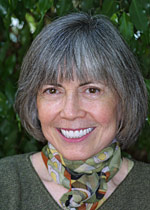 British Fantasy, Locus, and World Fantasy Award nominee, Anne Rice, is one of the most commercially successful authors in the WWEnd database. Why, then, would her next book not qualify to win any SF awards? Well, for starters, it isn’t a novel, and it isn’t SF (speculative fiction, for those not geeky enough to already know).
British Fantasy, Locus, and World Fantasy Award nominee, Anne Rice, is one of the most commercially successful authors in the WWEnd database. Why, then, would her next book not qualify to win any SF awards? Well, for starters, it isn’t a novel, and it isn’t SF (speculative fiction, for those not geeky enough to already know).
That isn’t why her fans are up in arms, however. This is: The book pretty much explains why she will never write another Anne Rice vampire thriller again.
Yes, that’s right, Anne is out of the Goth business (has been for a while, too). The Detroit Metro Times reviews her latest, entitled Called Out of Darkness: A Spiritual Confession. The autobiographical treatise details her (re)conversion to Catholicism and her abandonment of all things goth.
Personally, I think Catholicism is plenty goth, and vampyric tales are usually best told with heavy doses of the highly ritualized religion, which happens to be my own. Nevertheless, I’m sure plenty of WWEnd readers have opinions on this. Religion and goth horror… do they mix?



















 Full Details
Full Details
